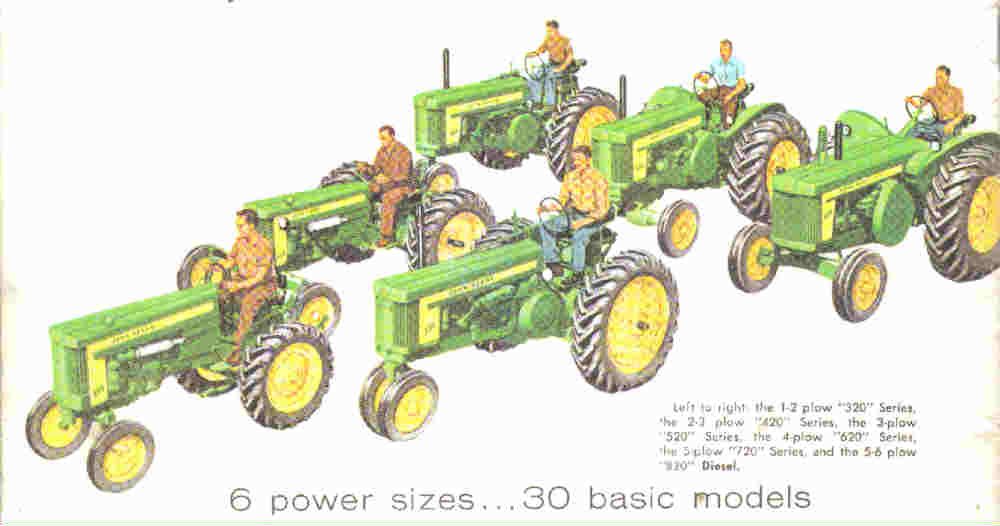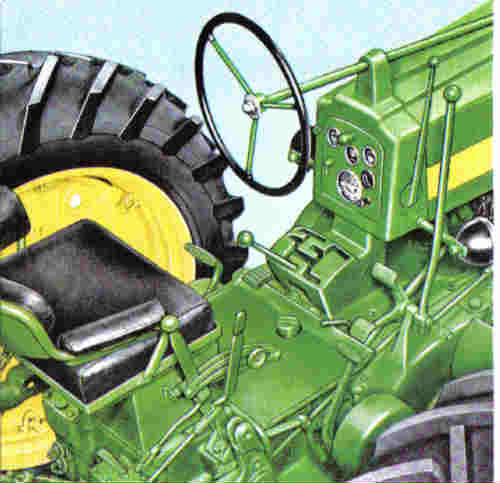The John Deere 620
Tractor offered bigger
profits to Farmers
|
|
John Deere 620 Full 4 plow power which set a new record
for fuel economy at Nebraska for gasoline tractors.
The John Deere Model 620 tractor was a direct replacement for the 60,
but it offered close to the same horsepower of the Model 70 at practically
the same price.
Even with it's advanced features and beautiful bright paint job, plus
improved operator convenience, a new Model 620 was only about 100
dollars more than what a new Model 70 had cost.
The 620 was advertised as a full 4 plow tractor with the power to
handle heavy loads continuously at speeds that would cut days off
a farmer's work calendar.
It had a bore and stroke of 5 1/2 x 6 3/8 inches, 321 cid, 1125 rpm,
44.16 drawbar and 48.68 belt horsepower.
Major changes were made to the Model 60 engine including: shorter
stroke, aluminum pistons, larger rod and main bearings, a stronger
crankshaft, redesigned cylinder head, and higher compression.
Another addition which made the engines run a bit smoother was the
distributor was now driven directly off the camshaft instead of previously
being driven through the governor. This was also incorporated on the
520 and 720.
The oldeere (pun intended) two cylinder tractors had fired on the
compression and exhaust stroke. With the new camshaft driven distributor
they now only fired on the compression stroke which allowed longer
point and spark plug life.
The John Deere 20 Series lineup of Tractors

Model 620 1956 to 1958
Variations of the John Deere Model 620 Tractor include:
620 general purpose
620 O
620 S
620 H
All models were available with either gasoline, all fuel or LP Gas
engines. Front end options were dual narrow, dual Roll O Matic, wide
front, or single wheel.

A major improvement on the 20 series of tractors was the hydraulic
system with Load and Depth Control. This system actually sensed
when more weight was needed on the rear wheels and if the load
became too much, the system would automatically raise the implement
enough to get it through a tough spot.
The Custom Powr Trol hydraulics had a stop which could be set by
the operator so that a precise working depth would be maintained
for each row once an implement was raised.
The new universal 3 point hitch on these tractors was a major
improvement over the old 800 and 800 A hitches. A new line of
integral equipment was developed especially for these tractors.
A new foot pedal was incorporated on the 520, 620 and 720 which
activated the PTO in place of the old style pull up lever.
A new dipstick was used on these tractors. With the old tractors a
valve was opened and if the oil ran out you knew it was full, if it
didn't a farmer would pour in oil until it ran out.
Tractors before serial #6213100 have green dash panels and black
generators. After that they had black dash panels and green generators.
Serial #6200004, the 4th Model 620 built was used as a yard tractor at
the Waterloo Tractor Works, it is still owned by John Deere, however has
been retired from active duty.
620 John Deere pulling a 490 John Deere Planter

The cost of a new 1958 Model 620 Tractor was $3,200
Shipping weight was 5858 pounds.
At Nebraska, the 620 set a new fuel economy record on the drawbar
for gasoline tractors and was second to the 520 for economy on LP Gas.
The 620 O was the last two cylinder orchard tractor. It continued to be
manufactured until February 1960.
There were a total of 22,532 Model 620 tractors built of all variations.
427 of these were orchard, 48 hi crops, 988 standards and the rest
row crops.
40 late production Model 620 tractors were shipped for assembly at
Monterrey, Mexico in February of 1958. Serial number tags for these
tractors had John Deere de Mexico stamped on them.
Next: Model 720 Tractor
Back to:
Model 520 Tractor
Return to: John Deere Tractors
|